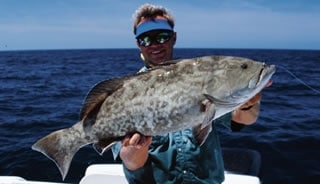
| McMillen shows off a 21-pound gag grouper he caught on a live pinfish in some 50 feet of water off Tarpon Springs, Florida. |
Conventional angling wisdom holds that a heavy hand and stout tackle are required to land big grouper, especially those that know how to swim the 50-meter backstroke into the craggiest hole they can find. But Kevin McMillen must have been absent the day conventional grouper wisdom was taught in school. Instead of the frantic cranking method, this veteran Florida charter captain uses a more subtle approach to capture these tasty bottom-dwellers. His results are impressive. So to learn more, I recently accompanied McMillen on one of his charters to the productive gag and red grouper grounds off west Florida.
“Basically, there are three steps to successful grouper fishing,” McMillen told me as we made the run from Tarpon Springs into the Gulf of Mexico. “You have to first find the fish, then make the presentation, and finally get them to the boat. I’ve found some of my best spots simply by putting the time in, looking and fishing dead water. Storms cover up some smaller structure and expose others. The really big rock piles and artificial reefs always remain exposed, however, and they get constant pressure from anglers and divers. Yes, they’ll hold big fish on occasion, but not for long, so I generally avoid them. Instead, I look for spots that I describe as beehives, smaller formations with holes where the grouper can get in and hide.”
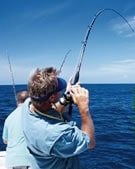
Captain Kevin McMillen does battle with a hefty grouper after using the advantage of surprise to gain line and keep the fish away from its rocky home.|
For redundancy and visual clarity, McMillen has two fishfinders – a Furuno GP-1650D and Garmin GPS125 – on his 30-foot Pro-Line center console. He scans them constantly whenever he’s on the move, as he’s always on the lookout for likely habitat. “I watch for the slightest deviation from the prevailing bottom,” he says. “Sometimes it’s only a foot or so of relief that hardly shows on the machines, but those little spots hold big grouper constantly. Once you find the fish, it’s just a matter of figuring out how to get them to bite on that particular day.”
Grunts for Grouper
In addition to his electronic surveillance, McMillen enlists the aid of other fish to help him pinpoint prime grouper areas. Mature grunts (14 inches or larger) or jumbo sea bass (16 inches plus) are good indicators that big grouper are in the vicinity. That’s because grouper generally leave these larger fish alone, but eat the smaller ones, McMillen believes. Conversely, an abundance of small grunts and sea bass often means the trophy grouper are elsewhere.
Although he will fish as shallow as 30 feet, McMillen prefers depths in the 50-foot range to give the grouper a comfortable distance from the boat. His self-imposed maximum depth limit is 65 feet so that released fish have a good chance of survival. Ideal conditions include no wind or current and minimal wave action, which make it easier to feel a bite.
Medium-action boat rods and high-speed Daiwa conventional reels make up McMillen’s grouper arsenal. He spools up with 80-pound Power Pro braided line and adds a 12- to 15-foot length of 50-pound monofilament leader. As the leader gets frayed, he’ll cut it back to as short as five feet before replacing it. Terminal tackle includes 7/0 to 9/0 long-shank J-hooks to match the bait, and a weight – the lighter, the better – connected above the hook via a dropper loop. He also uses heavy jigheads rigged with dead or cut baits as an alternative.
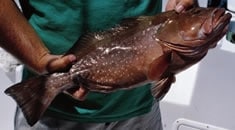
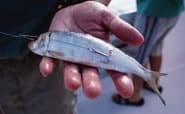
(top) Red grouper add a little color to the mix around low-profile structure. (bottom) McMillen often spices up the grouper action during the day by deploying a kingfish rod baited with a stinger-rigged cigar minnow.|
Go-To Grouper Getters
Clients are always instructed to start with the dead stuff before offering anything that’s still wiggling. Chunks of squid or fresh-cut grunts are the usual tidbits, and McMillen never leaves the dock without a box of frozen sardines (with tails removed for better scent). In the live-bait department, small jack crevalle, blue runners, grunts and pigfish aren’t usually turned down by grouper, but his go-to livies are ocean perch and jumbo pinfish, which “the big gags can’t resist.” He shuns live threadfin herring and other so-called “whitebaits,” because they never make it past other predators to reach the targeted species.
“It sometimes takes a little while for the big grouper to get excited,” McMillen says. “When they’re reluctant to bite, I chum just a bit to turn them on. I use anything and everything available, but only a few chunks at a time; I don’t want to draw in the sharks.”
McMillen occasionally employs a fresh water trick he learned from his grandfather. “I save the egg shells from my breakfast and bring them with me. If the bite is slow, I’ll bust a few shells into little pieces and toss them overboard. The pieces reflect the light, the baitfish gather to investigate and the grouper come out to feed. It’s simple, but it works.”
Wait to Strike
| ### Area ContactsIf you want a personal grouper session with Captain Kevin McMillen, full- and half-day charters are available. Spring (March through June) and fall/early-winter (September through December) are the prime months for gags, with red grouper mixed in. Call (727) 942-8446 or (727) 389-6360 for rates and availability.The Hampton Inn & Suites offers clean and comfortable accommodations nearby. Located at 39284 US 19 North in Tarpon Springs, it’s close to the historic sponge docks, marinas and restaurants. Call (727) 945-7755 or (800) 426-7866 for reservations. – D.L. |
Finally, there’s that part about getting a powerful gag or red grouper out of its lair and into the ice chest. Instead of immediately setting the hook and sending the grouper racing back to its rocky hole, McMillen advocates a more cunning approach. “If a big grouper feels safe and secure, he’ll venture outside his home,” he says. “If the fish finds a bait right near the bottom, and he’s comfortable, he’ll swallow it and go on about his business. If you don’t rear back and set the hook right away, he won’t panic, and will probably swim farther out, looking for something else to eat. Once the line starts to tighten, you can reel up any remaining slack and gain that critical advantage. At this point the fish will frantically try to make it back to his home, and you have to keep him out. That’s why I use high-speed reels, which allow you to pump and crank real quick.”
To demonstrate, McMillen grabbed a conventional outfit loaded with 30-pound line and dropped a live pinfish to the bottom after one of his clients missed a powerful strike. The line tightened as the big gag fed again, and McMillen reeled slowly. Suddenly, the fight was on, but with the element of surprise on his side, McMillen was able to gain the upper hand. After a short tug of war, the 34-inch, 21-pound grouper was lifted over the side. It was the largest fish of the day among the more than a dozen keepers landed, proving without a doubt that less is often more for grouper anglers who rely on brains rather than brawn.
| ### Bonus Kings |
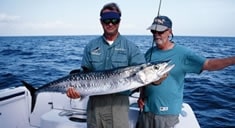
This 29-pound king mackerel – one of ten taken on the author’s “grouper” trip – hit McMillen’s cigar minnow bait.|
A versatile skipper, McMillen loves to combine his proven grouper tactics with an equally successful surface presentation for king mackerel up to 50 pounds (on our trip we caught ten kings along with our 50 grouper). After the grouper rigs are down, he casts a bait behind the boat with a spinning outfit and leaves it in a rod holder while tending to other chores. The enticing handout is rarely ignored.
McMillen, a Daiwa Pro Team member, uses a seven-foot, medium-action Sealine rod and a BG60 spinning reel for kingfish. The reel is loaded with 30-pound Power Pro braided line with a 20-foot top shot of fluorocarbon in the same line class. The drag setting is fairly light to avoid break-offs on the strike. Terminal tackle includes a short (less than a foot) wire trace with a swivel to reduce line twist, a No. 1 nose hook or small jighead, and a single trailing treble hook.
When targeting kings, McMillen prefers live lizardfish if he can find them. Large pinfish are used as a fallback, and he also has had excellent results with dead sardines. Besides kingfish, big Spanish mackerel are frequently taken using this same method. – Dave Lear









